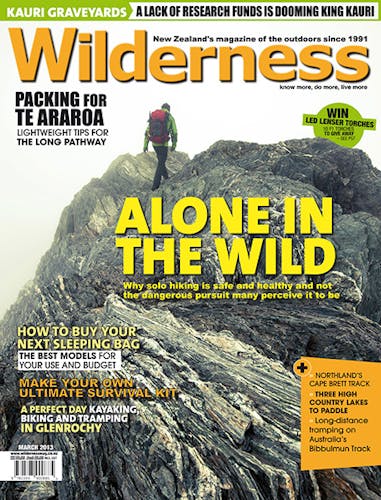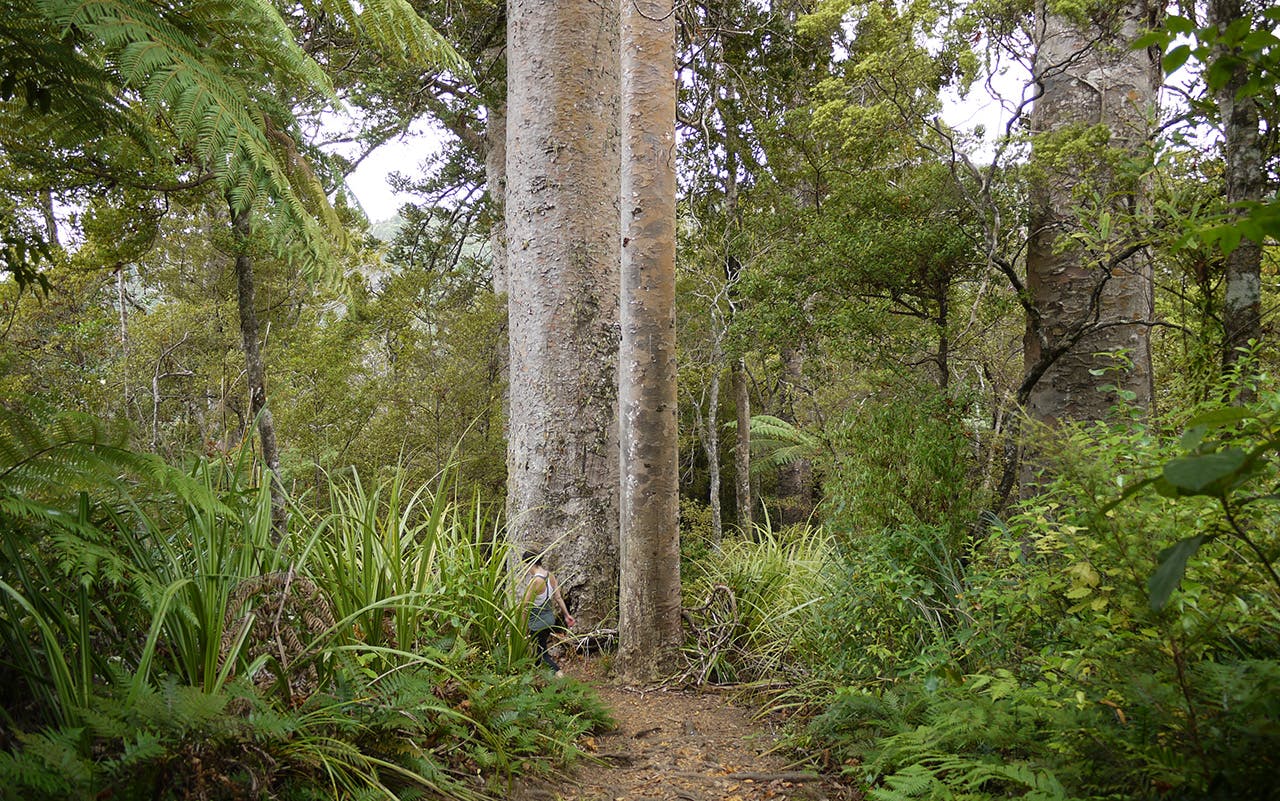- Time
- 3-3.5hr
- Grade
- Easy/Moderate
- Access
- From the Waitakere Reservoir car park on Scenic Drive
- Map
- BA31
Waitakere Tramway Track, Waitakere Ranges Regional Park
We pull into the car park on Scenic Drive not a moment too soon. Pelin, Wilderness magazine’s art director, doesn’t travel well and the winding journey has got her looking more pale than usual.
Fresh Waitakere air is just the solution, and pretty soon she’s back in colour as we stroll down the road, technically the Waitakere Reservoir Track but used by vehicles to access the reservoir.
A few hundred metres in, we take a short detour to a large kauri. It’s a few seconds’ walk to the tree which is one of the finer examples of kauri I’ve seen outside Northland and the Coromandel Peninsula.
Inspired by this giant of the forest we continue on to the reservoir, looking forward to the shade of the bush and getting off the tarmac and onto dirt.
We come across a number of sightseers at the reservoir, peering into Kelly Stream and the dense forest 100m below. Once across the dam, we finally enter the bush and immediately need to clean and spray our footwear at the trigene station to ensure we don’t spread kauri dieback. While we do this, a couple walks out of the bush and continue across the reservoir without stopping to clean their shoes. I wasn’t surprised – even though walkers are meant to stop and clean their shoes at all the trigene stations they come across, surveys have found only about 30 per cent of track users actually do.
We join the Fence Line Track and head towards the Auckland City Walk – the tramp we’ve planned is a mish-mash of tracks that handily make a loop.
Pretty soon we encounter more large kauri, some growing right next to the track with their roots crisscrossing from one side to the other and it’s impossible to avoid stepping on them. I don’t think I could ever tire of walking through kauri forests and am pleased to find the tree so prominent on this walk.
But I worry about their future: at the second cleaning station of the day, we are overtaken by another couple who ignore the signs requesting people clean and spray their shoes.
Here’s a little advice for those of you that do take the time to spray your shoes – let them dry before attempting to walk down steep, deeply rooted tracks. I didn’t, slipped and did the splits.
After a fairly steep descent that involves nimble-footed avoidance of roots and countless steps, we’re at the foot of Anderson Track. The trail continues on an easy gradient to Kelly Stream where a few well-placed rocks allow the sure-footed to leap across without getting wet. Pelin goes first and assures me the water is cold.
The easy going of the past 90-minutes is quickly forgotten as we huff our way up the steep ridge. Steps make it easier in places, but our thighs get a good work-out nonetheless. Halfway along the ridge is another trigene station and a sign warning walkers they are about to enter a patch of healthy kauri – failure to use the station is not an option here, folks.
Shortly after the station, the track enters a grove of kauri numbering in their hundreds. It’s a spectacular section of the walk and one of the highlights of the day, for sure.
About 15 minutes later we’re at our objective: the Waitakere Tramline Walk. This is an historic walk along a still functioning tramline that was built in 1905 to help in the construction of the reservoir. We’ve not been walking long when I start to hear the noise of traffic and think we must be closer to the road than I thought. A second later a loud whistle pierces the air and we look behind to see the tram chugging along the line. It’s loaded with tourists taking the easy route to the reservoir.
It takes us about half an hour to reach the reservoir on the track, passing through a tunnel and beneath a water race and spying a plump kereru (wood pigeon) in the canopy of kauri and a North Island Robin flitting from branch to branch beside the track.
There’s one final stretch left now – back up the road to the car park.








